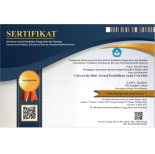DEVELOPMENT OF FLOOD DISASTER MITIGATION LEARNING MODEL IN EARLY CHILDHOOD EDUCATION
Abstract
This study aims to develop a learning model for flood disaster mitigation in Early Childhood. The research method used is the Research and Development (R&D) method. The research was carried out in several stages. The first stage, conducting a preliminary study and needs analysis (early data collection); the second stage, planning; The third stage, the development of the draft product in this case the Daily Lesson Plan development flood disaster mitigation, the fourth stage is the validation and trial stage. Based on research results, it was found that the development of the flood disaster mitigation learning model met the valid criteria of 3.50, 98% effective and practical test of 3.9 in learning flood disaster mitigation in early childhood. Thus, it can be concluded that the flood disaster mitigation model can be used for learning activities to introduce the concept of science and the concept of environmental care in Early Childhood, especially for children aged 4-6 years. The finding or novelty element in this study is the design of the flood disaster mitigation learning model is easier for children to understand, because the implementation of the model has been adapted to the characteristics and uses learning methods and approaches that are appropriate to the stages of development based on age levels.
Keywords
Full Text:
PDFReferences
Amri, S. (2013). Pengembangan & Model Pembelajaran Dalam Kurikulum 2013. Prestasi Pustaka.
Anggani, & Sudono. (2006). Sumber Belajar dan Alat Permainan Anak UsiaDini. Grasindo.
Hakim, A., Inten, D. N., & Mulyani, D. (2020). The Literation of Disaster Mitigation for Early Childhood. 409(SoRes 2019), 287–290. https://doi.org/10.2991/assehr.k.200225.060
Haman, S. A. (2020). PENGEMBANGAN BUKU PANDUAN KEGIATAN PEMBELAJARAN MITIGASI UNTUK MENINGKATKAN KESIAPSIAGAAN BENCANA BANJIR PADA ANAK USIA 5-6 TAHUN Sely Anisah Hanan. 1–15.
Hasbi, M., Yuliantina, I., Nurfadilah, & Nugraha, A. (2019). Pedoman Pendidikan Kebencanaan Pedoman Pendidikan Kebencanaan Di Satuan PAUD. Direktorat Jenderal Pendidikan Anak Usia Dini dan Pendidikan Masyarakat Kementerian Pendidikan dan Kebudayaan.
Helmiati. (2012). Model Pembelajaran. Aswaja Pressindo.
Hermon, D. (2012). Mitigasi Bencana Hidrometeorologi. In UNP Press.
Joyce, B. R., Weil, M., & Calhoun, E. (1996). Models of Teaching, 5th Edition. In Models of teaching.
Mujiburrahman, M., Nuraeni, N., & Hariawan, R. (2020). Pentingnya Pendidikan Kebencanaan Di Satuan Pendidikan Anak Usia Dini. JISIP (Jurnal Ilmu Sosial Dan Pendidikan), 4(2), 317–321. https://doi.org/10.36312/jisip.v4i2.1082
Noviana, E., Kurniaman, O., Munjiatun, Nugraheti Sismulyasih, S. B., & Nirmala, S. D. (2019). Why do primary school students need disaster mitigation knowledge? (study of the use of Koase Comics in primary schools). International Journal of Scientific and Technology Research, 8(11), 216–221.
Nuraeni, N., Mujiburrahman, M., & Hariawan, R. (2020). Manajemen Mitigasi Bencana pada Satuan Pendidikan Anak Usia Dini untuk Pengurangan Risiko bencana Gempa Bumi dan Tsunami. Jurnal Penelitian Dan Pengkajian Ilmu Pendidikan: E-Saintika, 4(1), 68. https://doi.org/10.36312/e-saintika.v4i1.200
Nurdyansyah, & Fahyuni, E. F. (2016). Inovasi Model Pembelajaran Sesuai Kurikulum 2013. In Nizmania Learning Center.
Prihadi, S. (2017). PEMBELAJARAN MITIGASI BENCANA BANJIR ( Studi Kasus : Pembelajaran Non Formal Anak-anak Bantaran Bengawan Solo di Desa Nusupan ). Prosiding Seminar Nasional Pendidikan Geografi FKIP UMP 2017, 45–50.
Sampurno, P. J., Sari, Y. A., & Wijaya, A. D. (2015). Integrating STEM (Science, Technology, Engineering, Mathematics) and Disaster (STEM-D) Education for Building Students’ Disaster Literacy. International Journal of Learning and Teaching. https://doi.org/10.18178/ijlt.1.1.73-76
Suarmika, P. E., & Utama, E. G. (2017). Pendidikan Mitigasi Bencana Di Sekolah Dasar (Sebuah Kajian Analisis Etnopedagogi). JPDI (Jurnal Pendidikan Dasar Indonesia), 2(2), 18. https://doi.org/10.26737/jpdi.v2i2.327
Sugiyono. (2016). Metode Penelitian Pendidikan Kuantitatif, kualitatif dan R & D. Bandung: Alfabeta. Metode Penelitian.
Twigg, J. (2004). Good Practice Review Disaster risk reduction. Disasters.
Osofsky,J.D., & Reuther, e.t.(2013). Young Children and Disasters: Lesson learned about resilience and recovery. Zero to Three, 34(2),46-54.
Winangsih, I., & Kurniati, E. (2020). Disaster Mitigation in Early Childhood Education. 454(Ecep 2019), 296–301. https://doi.org/10.2991/assehr.k.200808.058
DOI: https://doi.org/10.17509/cd.v12i2.38849
Refbacks
Copyright (c) 2021 UPI kampus cibiru

This work is licensed under a Creative Commons Attribution-ShareAlike 4.0 International License.
Cakrawala Dini: Jurnal Pendidikan Anak Usia Dini
Published in collaboration Program Studi PGPAUD UPI Kampus Cibiru, APG PAUD Indonesia, and PPJ PAUD Indonesia

Cakrawala Dini: Jurnal Pendidikan Anak Usia Dini is licensed under a Creative Commons Attribution-ShareAlike 4.0 International License.
Based on a work at https://ejournal.upi.edu/index.php/cakrawaladini.














